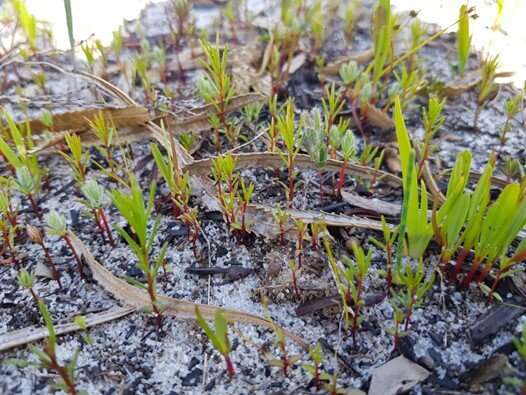This article has been reviewed according to Science X's editorial process and policies. Editors have highlighted the following attributes while ensuring the content's credibility:
fact-checked
trusted source
proofread
Smoke activated seed banks found to rapidly re-establish banksia woodlands after fire

Banksia woodlands are an iconic ecosystem around the Perth region. They are home to more than 600 plant species and the banksia trees that grow in deep, nutrient poor sands are an important habitat for many threatened species, like black cockatoos, chuditch and western ringtail possums.
These special landscapes are also prone to fire and new research from the Harry Butler Institute in collaboration with Kings Park Science and Hanson Construction Materials shows how they can regenerate purely from seeds in banksia woodlands restored after mining.
While many plant species are killed by fire, the study shows that banksias and the plants they share the land with rapidly regenerate through seeds stored in soil seedbanks that respond to cues from fire, like smoke and heat.
"To understand how the soil seedbank develops with time, instead of using the standard method of collecting soil and germinating seeds in a glasshouse, we smoked soil in the field and let germination occur under field conditions," said Ph.D. student Ebony Cowan, who led the study.
"By igniting plant material and letting smoke linger over soil in plots, we stimulated the germination of plant species typical of banksia woodland, allowing us to understand how the restored vegetation may respond to fire."
In fire-prone ecosystems, the regeneration of plant communities is usually influenced by time since fire. Some plants will resprout from existing plant material (rootstock) and others will regenerate from seeds.
Next, plants develop resources to help them cope with the next fire, typically by developing resprouting buds or seedbanks. However, if it is too short or too long between one fire and the next, buds may not develop or begin to die, and seeds may not be available or viable.
While similar processes are expected to occur after mining, its unclear when plants can regenerate from seeds. Has there been enough time for plants to accumulate a seedbank or develop rootstock so new seedlings can come up after fire?
Determining the sweet spot for when fire may promote regeneration can be difficult in part because it varies among species and site age.
"Our research assessed how soil seedbanks developed in restored vegetation aged between three and 26 years since the onset of restoration to determine how age influenced the plants response to fire," said Cowan.
The researchers found seeds germinating from every age, which is good news because it suggests that regeneration from seeds after fire is possible, even in newly restored vegetation.
"For perennial species, which are most of the species in the ecosystem and are therefore important for biodiversity conservation and ecosystem functions, we found their soil seedbank became more similar to the above-ground, established vegetation in older ages," explained Cowan.
"This suggests that fire in older ages will result in a similar vegetation community to what was there before fire."
Measuring plant species above-ground and seeds below-ground can provide valuable insights for predicting responses to disturbances. Doing so can help to understand if an ecosystem should come back to a similar state and managers can change practices if they need to.
"In a time of biodiversity loss, ensuring restored vegetation can respond to disturbances is important for its long-term persistence."
The research is published in the journal Applied Vegetation Science.
Cowan will now look at other responses to fire in restored landscapes to help gain a more comprehensive picture of how fire may influence these plant communities, and the role of other factors like climate and soil conditions may have.
More information: Ebony L. Cowan et al, Soil seedbank development of smoke‐responsive plant species in a 23‐year restoration chronosequence and implications for resilience to fire, Applied Vegetation Science (2023). DOI: 10.1111/avsc.12713
Provided by Murdoch University



















